Corporate Governance Case Study: James Hardie
VerifiedAdded on 2020/02/24
|9
|2511
|190
Case Study
AI Summary
The case study analyzes the landmark decision of the Australian Securities and Investments Commission v Macdonald, focusing on the breaches of duties by directors and executives at James Hardie Industries. It highlights the importance of corporate governance, the responsibilities of senior executives, and the implications of misleading public representations. The case serves as a critical reference for understanding the legal obligations of directors under Australian law and the consequences of non-compliance.
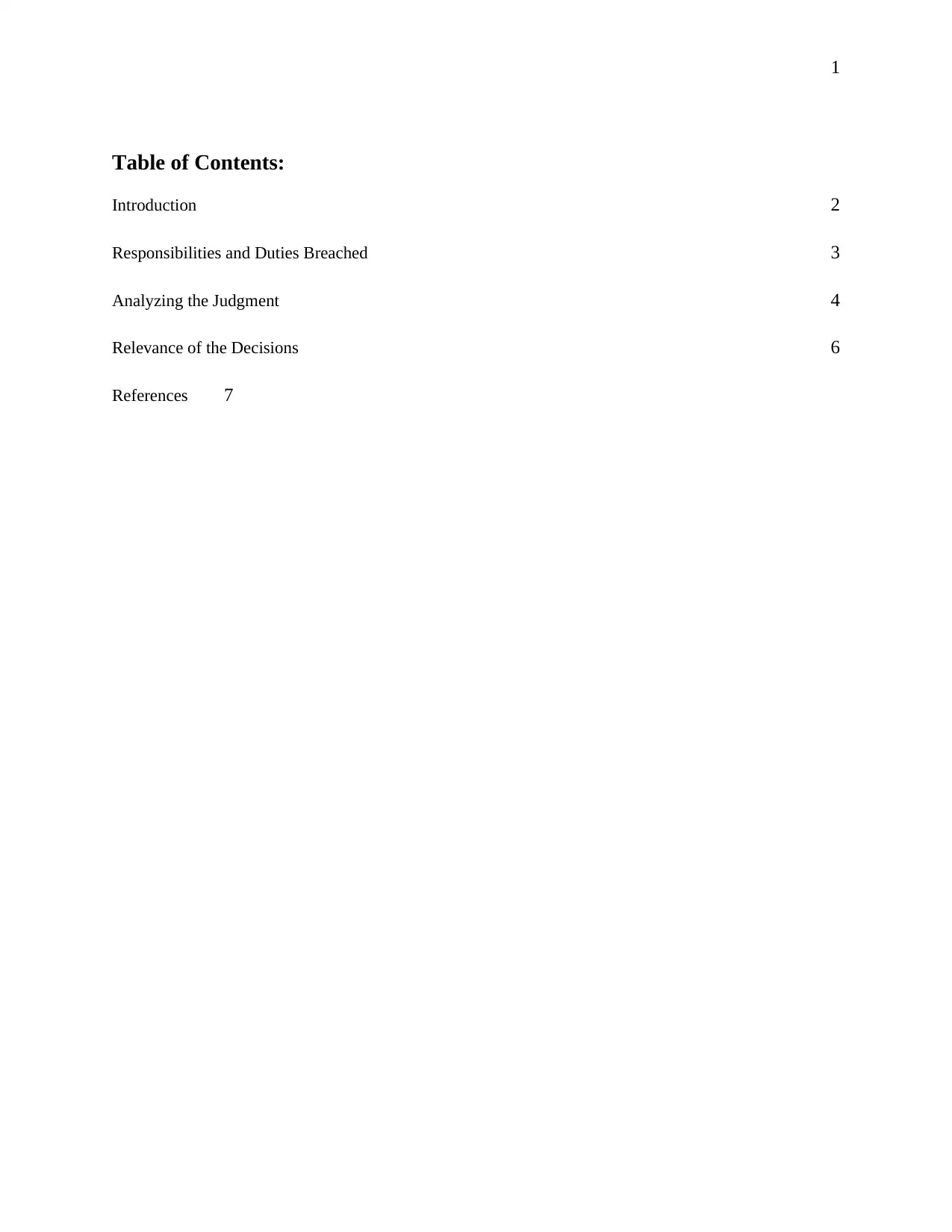
1
Table of Contents:
Introduction 2
Responsibilities and Duties Breached 3
Analyzing the Judgment 4
Relevance of the Decisions 6
References 7
Table of Contents:
Introduction 2
Responsibilities and Duties Breached 3
Analyzing the Judgment 4
Relevance of the Decisions 6
References 7
Paraphrase This Document
Need a fresh take? Get an instant paraphrase of this document with our AI Paraphraser
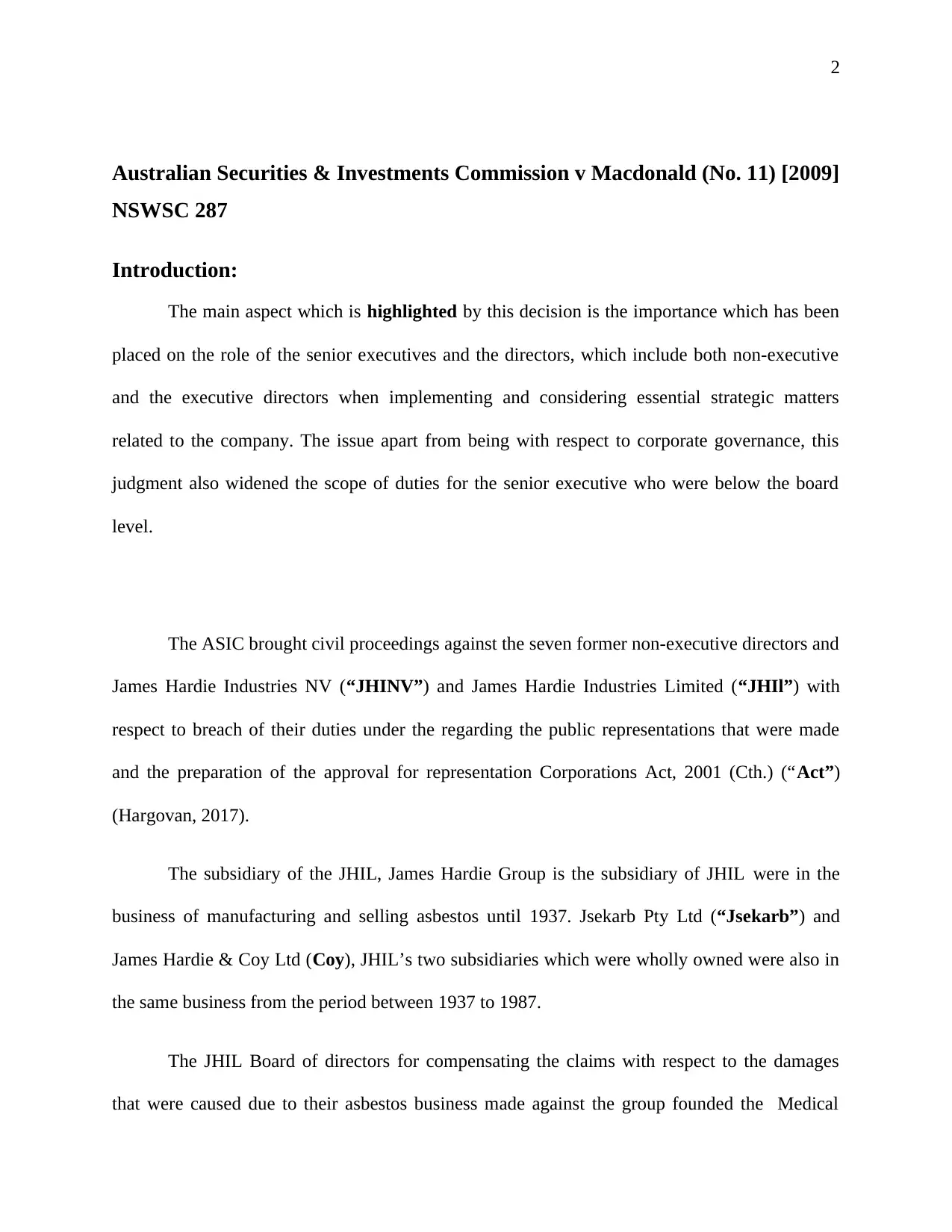
2
Australian Securities & Investments Commission v Macdonald (No. 11) [2009]
NSWSC 287
Introduction:
The main aspect which is highlighted by this decision is the importance which has been
placed on the role of the senior executives and the directors, which include both non-executive
and the executive directors when implementing and considering essential strategic matters
related to the company. The issue apart from being with respect to corporate governance, this
judgment also widened the scope of duties for the senior executive who were below the board
level.
The ASIC brought civil proceedings against the seven former non-executive directors and
James Hardie Industries NV (“JHINV”) and James Hardie Industries Limited (“JHIl”) with
respect to breach of their duties under the regarding the public representations that were made
and the preparation of the approval for representation Corporations Act, 2001 (Cth.) (“Act”)
(Hargovan, 2017).
The subsidiary of the JHIL, James Hardie Group is the subsidiary of JHIL were in the
business of manufacturing and selling asbestos until 1937. Jsekarb Pty Ltd (“Jsekarb”) and
James Hardie & Coy Ltd (Coy), JHIL’s two subsidiaries which were wholly owned were also in
the same business from the period between 1937 to 1987.
The JHIL Board of directors for compensating the claims with respect to the damages
that were caused due to their asbestos business made against the group founded the Medical
Australian Securities & Investments Commission v Macdonald (No. 11) [2009]
NSWSC 287
Introduction:
The main aspect which is highlighted by this decision is the importance which has been
placed on the role of the senior executives and the directors, which include both non-executive
and the executive directors when implementing and considering essential strategic matters
related to the company. The issue apart from being with respect to corporate governance, this
judgment also widened the scope of duties for the senior executive who were below the board
level.
The ASIC brought civil proceedings against the seven former non-executive directors and
James Hardie Industries NV (“JHINV”) and James Hardie Industries Limited (“JHIl”) with
respect to breach of their duties under the regarding the public representations that were made
and the preparation of the approval for representation Corporations Act, 2001 (Cth.) (“Act”)
(Hargovan, 2017).
The subsidiary of the JHIL, James Hardie Group is the subsidiary of JHIL were in the
business of manufacturing and selling asbestos until 1937. Jsekarb Pty Ltd (“Jsekarb”) and
James Hardie & Coy Ltd (Coy), JHIL’s two subsidiaries which were wholly owned were also in
the same business from the period between 1937 to 1987.
The JHIL Board of directors for compensating the claims with respect to the damages
that were caused due to their asbestos business made against the group founded the Medical
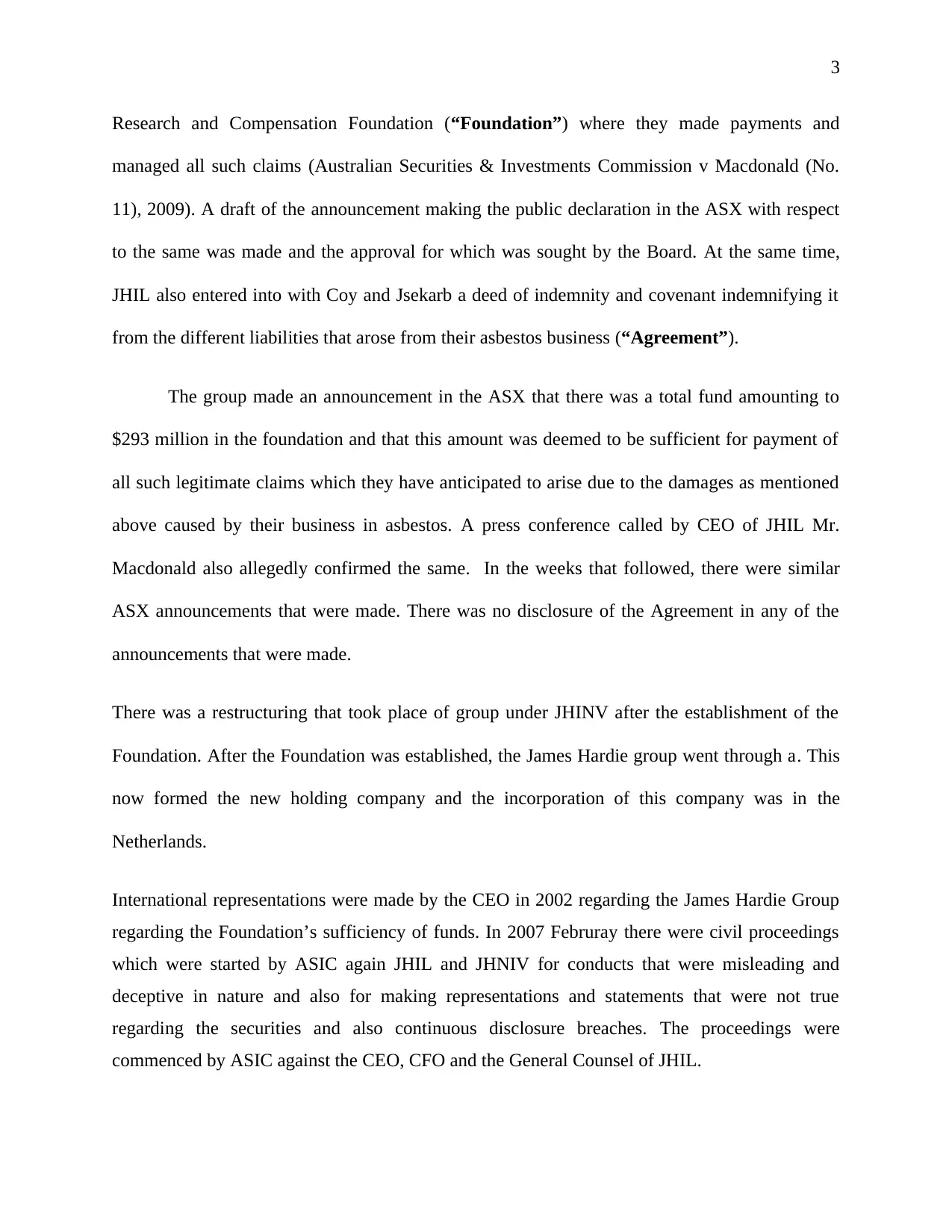
3
Research and Compensation Foundation (“Foundation”) where they made payments and
managed all such claims (Australian Securities & Investments Commission v Macdonald (No.
11), 2009). A draft of the announcement making the public declaration in the ASX with respect
to the same was made and the approval for which was sought by the Board. At the same time,
JHIL also entered into with Coy and Jsekarb a deed of indemnity and covenant indemnifying it
from the different liabilities that arose from their asbestos business (“Agreement”).
The group made an announcement in the ASX that there was a total fund amounting to
$293 million in the foundation and that this amount was deemed to be sufficient for payment of
all such legitimate claims which they have anticipated to arise due to the damages as mentioned
above caused by their business in asbestos. A press conference called by CEO of JHIL Mr.
Macdonald also allegedly confirmed the same. In the weeks that followed, there were similar
ASX announcements that were made. There was no disclosure of the Agreement in any of the
announcements that were made.
There was a restructuring that took place of group under JHINV after the establishment of the
Foundation. After the Foundation was established, the James Hardie group went through a. This
now formed the new holding company and the incorporation of this company was in the
Netherlands.
International representations were made by the CEO in 2002 regarding the James Hardie Group
regarding the Foundation’s sufficiency of funds. In 2007 Februray there were civil proceedings
which were started by ASIC again JHIL and JHNIV for conducts that were misleading and
deceptive in nature and also for making representations and statements that were not true
regarding the securities and also continuous disclosure breaches. The proceedings were
commenced by ASIC against the CEO, CFO and the General Counsel of JHIL.
Research and Compensation Foundation (“Foundation”) where they made payments and
managed all such claims (Australian Securities & Investments Commission v Macdonald (No.
11), 2009). A draft of the announcement making the public declaration in the ASX with respect
to the same was made and the approval for which was sought by the Board. At the same time,
JHIL also entered into with Coy and Jsekarb a deed of indemnity and covenant indemnifying it
from the different liabilities that arose from their asbestos business (“Agreement”).
The group made an announcement in the ASX that there was a total fund amounting to
$293 million in the foundation and that this amount was deemed to be sufficient for payment of
all such legitimate claims which they have anticipated to arise due to the damages as mentioned
above caused by their business in asbestos. A press conference called by CEO of JHIL Mr.
Macdonald also allegedly confirmed the same. In the weeks that followed, there were similar
ASX announcements that were made. There was no disclosure of the Agreement in any of the
announcements that were made.
There was a restructuring that took place of group under JHINV after the establishment of the
Foundation. After the Foundation was established, the James Hardie group went through a. This
now formed the new holding company and the incorporation of this company was in the
Netherlands.
International representations were made by the CEO in 2002 regarding the James Hardie Group
regarding the Foundation’s sufficiency of funds. In 2007 Februray there were civil proceedings
which were started by ASIC again JHIL and JHNIV for conducts that were misleading and
deceptive in nature and also for making representations and statements that were not true
regarding the securities and also continuous disclosure breaches. The proceedings were
commenced by ASIC against the CEO, CFO and the General Counsel of JHIL.
⊘ This is a preview!⊘
Do you want full access?
Subscribe today to unlock all pages.

Trusted by 1+ million students worldwide
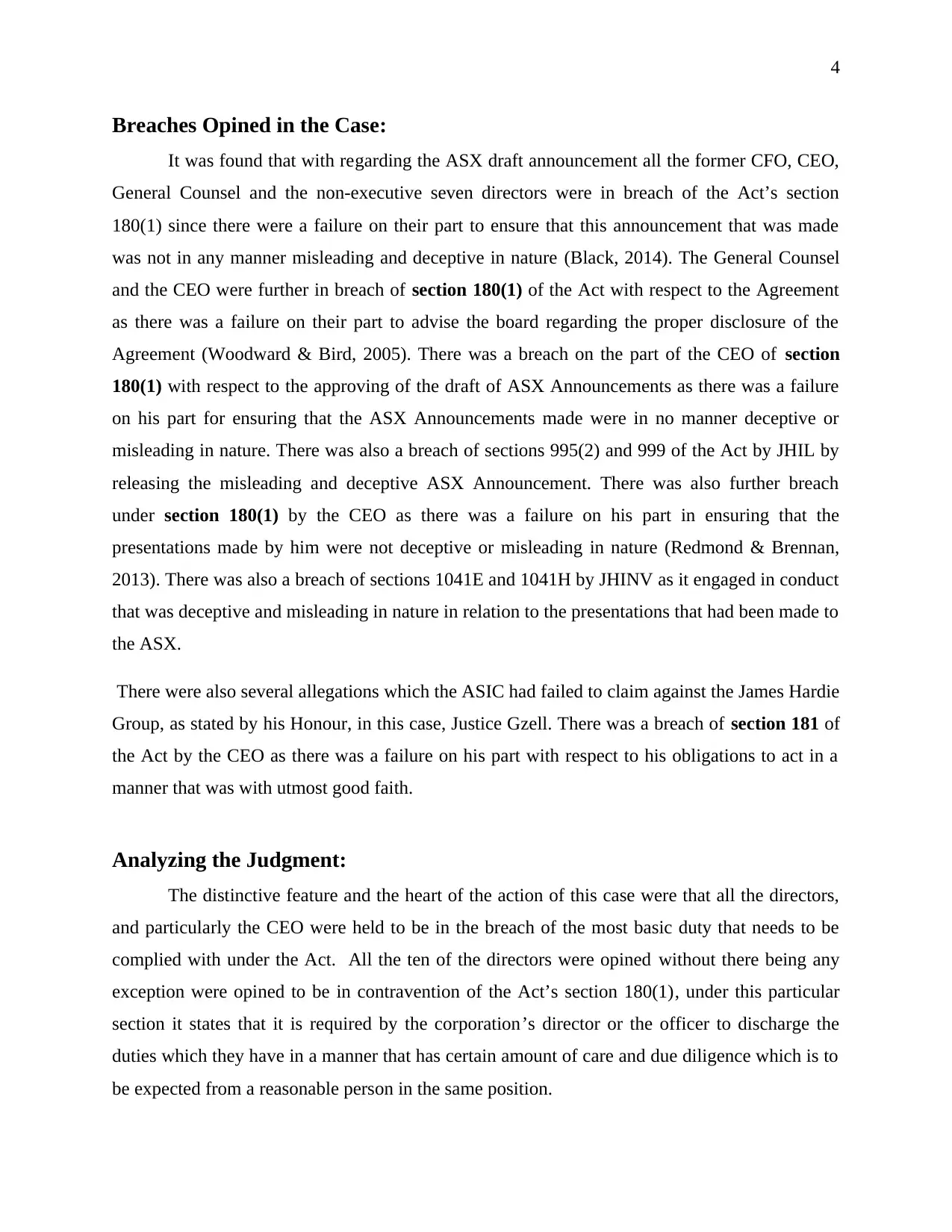
4
Breaches Opined in the Case:
It was found that with regarding the ASX draft announcement all the former CFO, CEO,
General Counsel and the non-executive seven directors were in breach of the Act’s section
180(1) since there were a failure on their part to ensure that this announcement that was made
was not in any manner misleading and deceptive in nature (Black, 2014). The General Counsel
and the CEO were further in breach of section 180(1) of the Act with respect to the Agreement
as there was a failure on their part to advise the board regarding the proper disclosure of the
Agreement (Woodward & Bird, 2005). There was a breach on the part of the CEO of section
180(1) with respect to the approving of the draft of ASX Announcements as there was a failure
on his part for ensuring that the ASX Announcements made were in no manner deceptive or
misleading in nature. There was also a breach of sections 995(2) and 999 of the Act by JHIL by
releasing the misleading and deceptive ASX Announcement. There was also further breach
under section 180(1) by the CEO as there was a failure on his part in ensuring that the
presentations made by him were not deceptive or misleading in nature (Redmond & Brennan,
2013). There was also a breach of sections 1041E and 1041H by JHINV as it engaged in conduct
that was deceptive and misleading in nature in relation to the presentations that had been made to
the ASX.
There were also several allegations which the ASIC had failed to claim against the James Hardie
Group, as stated by his Honour, in this case, Justice Gzell. There was a breach of section 181 of
the Act by the CEO as there was a failure on his part with respect to his obligations to act in a
manner that was with utmost good faith.
Analyzing the Judgment:
The distinctive feature and the heart of the action of this case were that all the directors,
and particularly the CEO were held to be in the breach of the most basic duty that needs to be
complied with under the Act. All the ten of the directors were opined without there being any
exception were opined to be in contravention of the Act’s section 180(1), under this particular
section it states that it is required by the corporation’s director or the officer to discharge the
duties which they have in a manner that has certain amount of care and due diligence which is to
be expected from a reasonable person in the same position.
Breaches Opined in the Case:
It was found that with regarding the ASX draft announcement all the former CFO, CEO,
General Counsel and the non-executive seven directors were in breach of the Act’s section
180(1) since there were a failure on their part to ensure that this announcement that was made
was not in any manner misleading and deceptive in nature (Black, 2014). The General Counsel
and the CEO were further in breach of section 180(1) of the Act with respect to the Agreement
as there was a failure on their part to advise the board regarding the proper disclosure of the
Agreement (Woodward & Bird, 2005). There was a breach on the part of the CEO of section
180(1) with respect to the approving of the draft of ASX Announcements as there was a failure
on his part for ensuring that the ASX Announcements made were in no manner deceptive or
misleading in nature. There was also a breach of sections 995(2) and 999 of the Act by JHIL by
releasing the misleading and deceptive ASX Announcement. There was also further breach
under section 180(1) by the CEO as there was a failure on his part in ensuring that the
presentations made by him were not deceptive or misleading in nature (Redmond & Brennan,
2013). There was also a breach of sections 1041E and 1041H by JHINV as it engaged in conduct
that was deceptive and misleading in nature in relation to the presentations that had been made to
the ASX.
There were also several allegations which the ASIC had failed to claim against the James Hardie
Group, as stated by his Honour, in this case, Justice Gzell. There was a breach of section 181 of
the Act by the CEO as there was a failure on his part with respect to his obligations to act in a
manner that was with utmost good faith.
Analyzing the Judgment:
The distinctive feature and the heart of the action of this case were that all the directors,
and particularly the CEO were held to be in the breach of the most basic duty that needs to be
complied with under the Act. All the ten of the directors were opined without there being any
exception were opined to be in contravention of the Act’s section 180(1), under this particular
section it states that it is required by the corporation’s director or the officer to discharge the
duties which they have in a manner that has certain amount of care and due diligence which is to
be expected from a reasonable person in the same position.
Paraphrase This Document
Need a fresh take? Get an instant paraphrase of this document with our AI Paraphraser
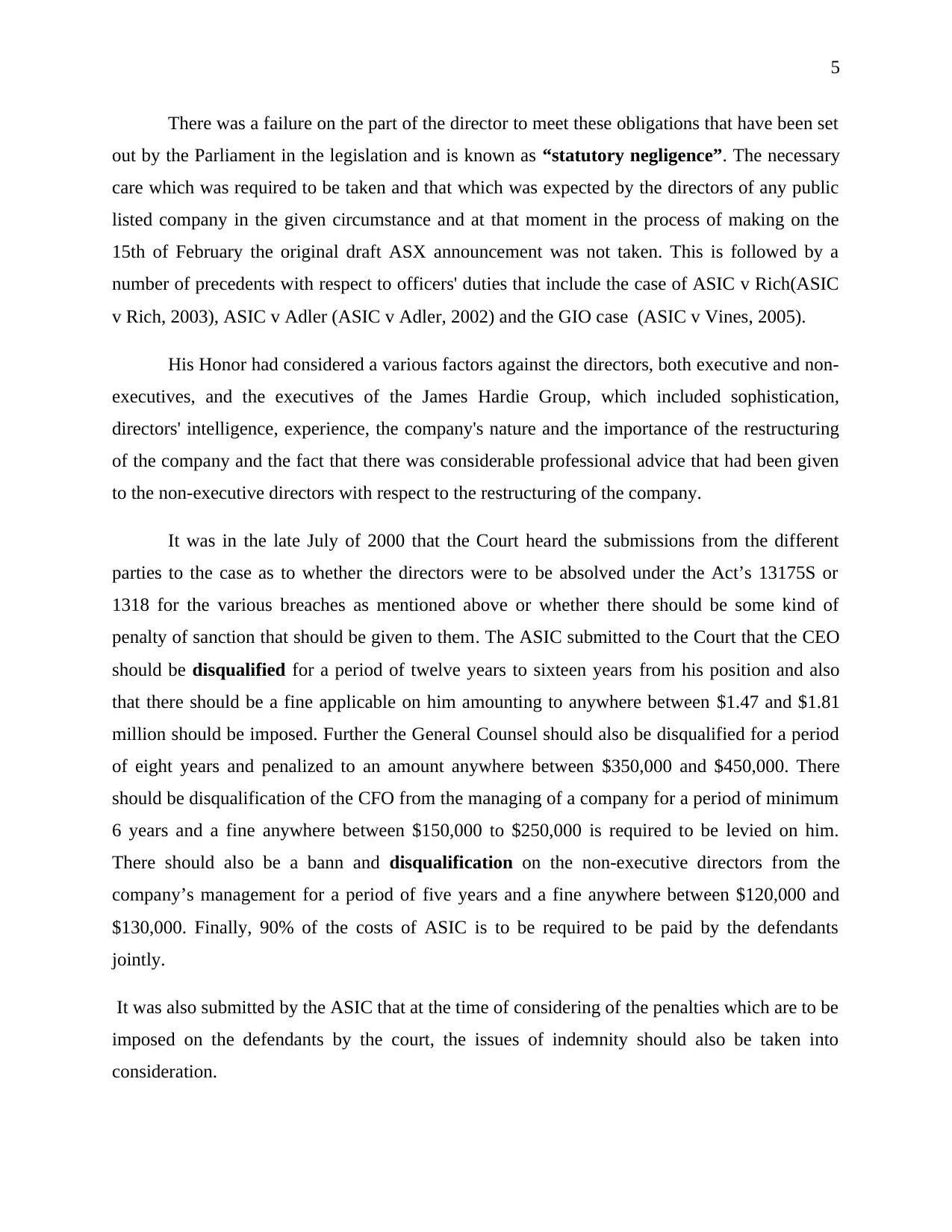
5
There was a failure on the part of the director to meet these obligations that have been set
out by the Parliament in the legislation and is known as “statutory negligence”. The necessary
care which was required to be taken and that which was expected by the directors of any public
listed company in the given circumstance and at that moment in the process of making on the
15th of February the original draft ASX announcement was not taken. This is followed by a
number of precedents with respect to officers' duties that include the case of ASIC v Rich(ASIC
v Rich, 2003), ASIC v Adler (ASIC v Adler, 2002) and the GIO case (ASIC v Vines, 2005).
His Honor had considered a various factors against the directors, both executive and non-
executives, and the executives of the James Hardie Group, which included sophistication,
directors' intelligence, experience, the company's nature and the importance of the restructuring
of the company and the fact that there was considerable professional advice that had been given
to the non-executive directors with respect to the restructuring of the company.
It was in the late July of 2000 that the Court heard the submissions from the different
parties to the case as to whether the directors were to be absolved under the Act’s 13175S or
1318 for the various breaches as mentioned above or whether there should be some kind of
penalty of sanction that should be given to them. The ASIC submitted to the Court that the CEO
should be disqualified for a period of twelve years to sixteen years from his position and also
that there should be a fine applicable on him amounting to anywhere between $1.47 and $1.81
million should be imposed. Further the General Counsel should also be disqualified for a period
of eight years and penalized to an amount anywhere between $350,000 and $450,000. There
should be disqualification of the CFO from the managing of a company for a period of minimum
6 years and a fine anywhere between $150,000 to $250,000 is required to be levied on him.
There should also be a bann and disqualification on the non-executive directors from the
company’s management for a period of five years and a fine anywhere between $120,000 and
$130,000. Finally, 90% of the costs of ASIC is to be required to be paid by the defendants
jointly.
It was also submitted by the ASIC that at the time of considering of the penalties which are to be
imposed on the defendants by the court, the issues of indemnity should also be taken into
consideration.
There was a failure on the part of the director to meet these obligations that have been set
out by the Parliament in the legislation and is known as “statutory negligence”. The necessary
care which was required to be taken and that which was expected by the directors of any public
listed company in the given circumstance and at that moment in the process of making on the
15th of February the original draft ASX announcement was not taken. This is followed by a
number of precedents with respect to officers' duties that include the case of ASIC v Rich(ASIC
v Rich, 2003), ASIC v Adler (ASIC v Adler, 2002) and the GIO case (ASIC v Vines, 2005).
His Honor had considered a various factors against the directors, both executive and non-
executives, and the executives of the James Hardie Group, which included sophistication,
directors' intelligence, experience, the company's nature and the importance of the restructuring
of the company and the fact that there was considerable professional advice that had been given
to the non-executive directors with respect to the restructuring of the company.
It was in the late July of 2000 that the Court heard the submissions from the different
parties to the case as to whether the directors were to be absolved under the Act’s 13175S or
1318 for the various breaches as mentioned above or whether there should be some kind of
penalty of sanction that should be given to them. The ASIC submitted to the Court that the CEO
should be disqualified for a period of twelve years to sixteen years from his position and also
that there should be a fine applicable on him amounting to anywhere between $1.47 and $1.81
million should be imposed. Further the General Counsel should also be disqualified for a period
of eight years and penalized to an amount anywhere between $350,000 and $450,000. There
should be disqualification of the CFO from the managing of a company for a period of minimum
6 years and a fine anywhere between $150,000 to $250,000 is required to be levied on him.
There should also be a bann and disqualification on the non-executive directors from the
company’s management for a period of five years and a fine anywhere between $120,000 and
$130,000. Finally, 90% of the costs of ASIC is to be required to be paid by the defendants
jointly.
It was also submitted by the ASIC that at the time of considering of the penalties which are to be
imposed on the defendants by the court, the issues of indemnity should also be taken into
consideration.
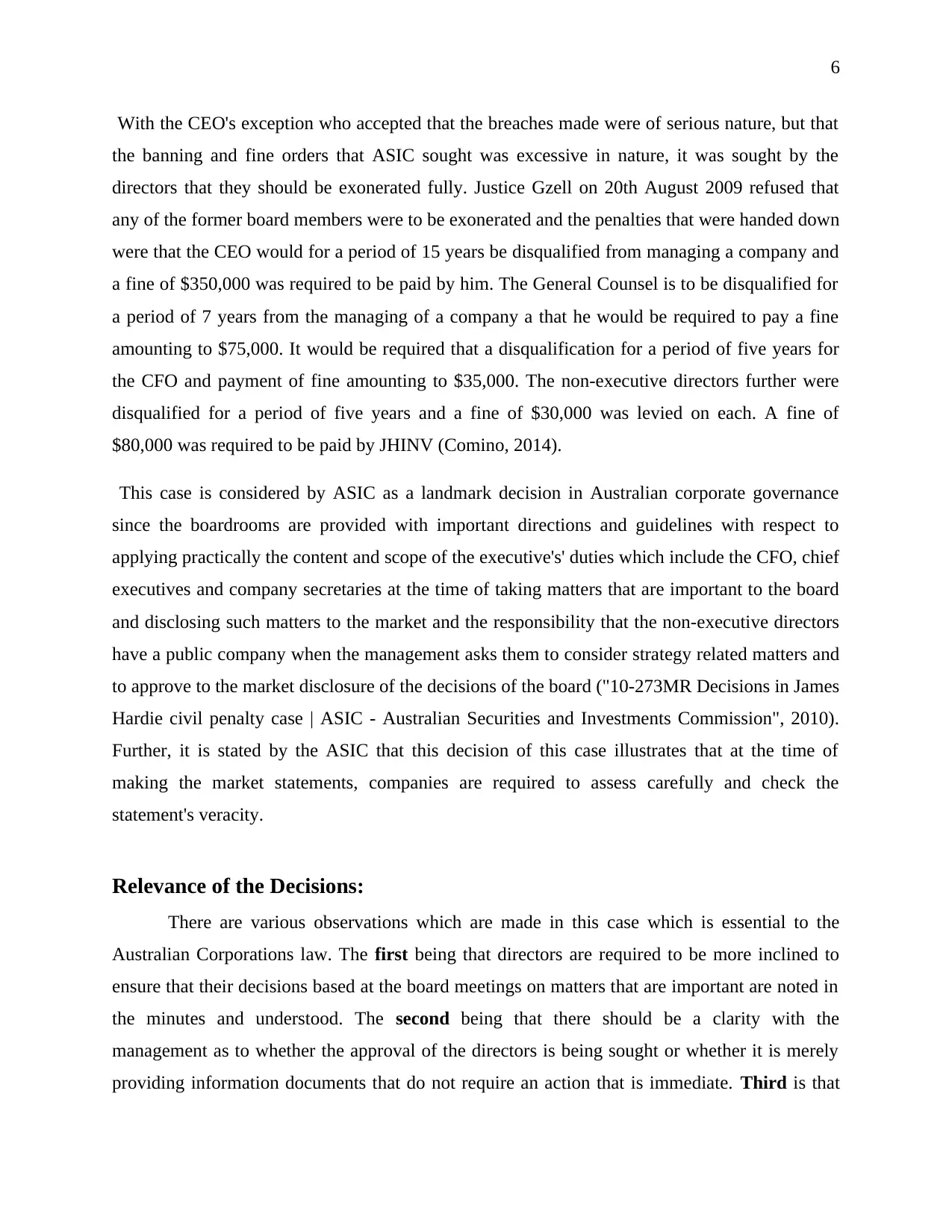
6
With the CEO's exception who accepted that the breaches made were of serious nature, but that
the banning and fine orders that ASIC sought was excessive in nature, it was sought by the
directors that they should be exonerated fully. Justice Gzell on 20th August 2009 refused that
any of the former board members were to be exonerated and the penalties that were handed down
were that the CEO would for a period of 15 years be disqualified from managing a company and
a fine of $350,000 was required to be paid by him. The General Counsel is to be disqualified for
a period of 7 years from the managing of a company a that he would be required to pay a fine
amounting to $75,000. It would be required that a disqualification for a period of five years for
the CFO and payment of fine amounting to $35,000. The non-executive directors further were
disqualified for a period of five years and a fine of $30,000 was levied on each. A fine of
$80,000 was required to be paid by JHINV (Comino, 2014).
This case is considered by ASIC as a landmark decision in Australian corporate governance
since the boardrooms are provided with important directions and guidelines with respect to
applying practically the content and scope of the executive's' duties which include the CFO, chief
executives and company secretaries at the time of taking matters that are important to the board
and disclosing such matters to the market and the responsibility that the non-executive directors
have a public company when the management asks them to consider strategy related matters and
to approve to the market disclosure of the decisions of the board ("10-273MR Decisions in James
Hardie civil penalty case | ASIC - Australian Securities and Investments Commission", 2010).
Further, it is stated by the ASIC that this decision of this case illustrates that at the time of
making the market statements, companies are required to assess carefully and check the
statement's veracity.
Relevance of the Decisions:
There are various observations which are made in this case which is essential to the
Australian Corporations law. The first being that directors are required to be more inclined to
ensure that their decisions based at the board meetings on matters that are important are noted in
the minutes and understood. The second being that there should be a clarity with the
management as to whether the approval of the directors is being sought or whether it is merely
providing information documents that do not require an action that is immediate. Third is that
With the CEO's exception who accepted that the breaches made were of serious nature, but that
the banning and fine orders that ASIC sought was excessive in nature, it was sought by the
directors that they should be exonerated fully. Justice Gzell on 20th August 2009 refused that
any of the former board members were to be exonerated and the penalties that were handed down
were that the CEO would for a period of 15 years be disqualified from managing a company and
a fine of $350,000 was required to be paid by him. The General Counsel is to be disqualified for
a period of 7 years from the managing of a company a that he would be required to pay a fine
amounting to $75,000. It would be required that a disqualification for a period of five years for
the CFO and payment of fine amounting to $35,000. The non-executive directors further were
disqualified for a period of five years and a fine of $30,000 was levied on each. A fine of
$80,000 was required to be paid by JHINV (Comino, 2014).
This case is considered by ASIC as a landmark decision in Australian corporate governance
since the boardrooms are provided with important directions and guidelines with respect to
applying practically the content and scope of the executive's' duties which include the CFO, chief
executives and company secretaries at the time of taking matters that are important to the board
and disclosing such matters to the market and the responsibility that the non-executive directors
have a public company when the management asks them to consider strategy related matters and
to approve to the market disclosure of the decisions of the board ("10-273MR Decisions in James
Hardie civil penalty case | ASIC - Australian Securities and Investments Commission", 2010).
Further, it is stated by the ASIC that this decision of this case illustrates that at the time of
making the market statements, companies are required to assess carefully and check the
statement's veracity.
Relevance of the Decisions:
There are various observations which are made in this case which is essential to the
Australian Corporations law. The first being that directors are required to be more inclined to
ensure that their decisions based at the board meetings on matters that are important are noted in
the minutes and understood. The second being that there should be a clarity with the
management as to whether the approval of the directors is being sought or whether it is merely
providing information documents that do not require an action that is immediate. Third is that
⊘ This is a preview!⊘
Do you want full access?
Subscribe today to unlock all pages.

Trusted by 1+ million students worldwide
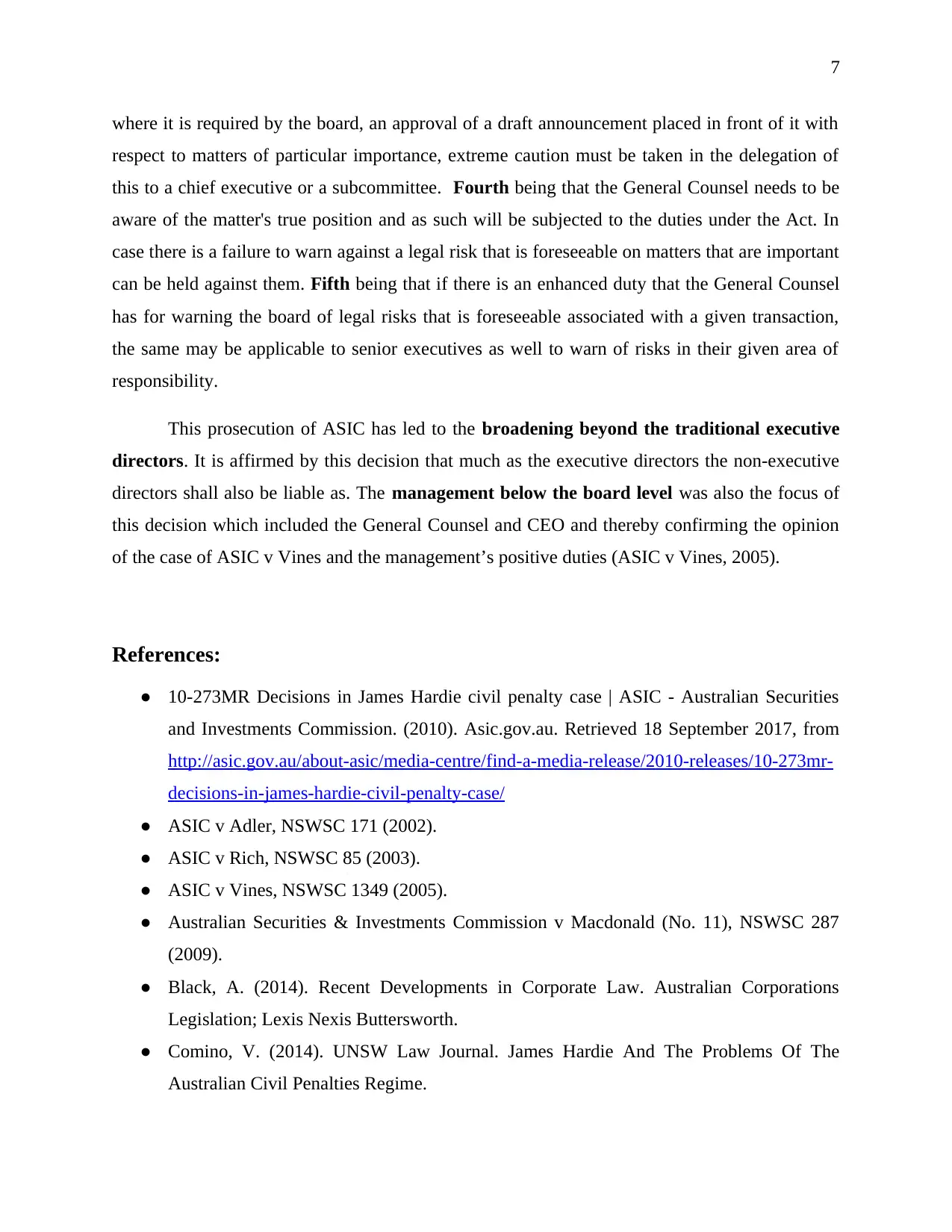
7
where it is required by the board, an approval of a draft announcement placed in front of it with
respect to matters of particular importance, extreme caution must be taken in the delegation of
this to a chief executive or a subcommittee. Fourth being that the General Counsel needs to be
aware of the matter's true position and as such will be subjected to the duties under the Act. In
case there is a failure to warn against a legal risk that is foreseeable on matters that are important
can be held against them. Fifth being that if there is an enhanced duty that the General Counsel
has for warning the board of legal risks that is foreseeable associated with a given transaction,
the same may be applicable to senior executives as well to warn of risks in their given area of
responsibility.
This prosecution of ASIC has led to the broadening beyond the traditional executive
directors. It is affirmed by this decision that much as the executive directors the non-executive
directors shall also be liable as. The management below the board level was also the focus of
this decision which included the General Counsel and CEO and thereby confirming the opinion
of the case of ASIC v Vines and the management’s positive duties (ASIC v Vines, 2005).
References:
● 10-273MR Decisions in James Hardie civil penalty case | ASIC - Australian Securities
and Investments Commission. (2010). Asic.gov.au. Retrieved 18 September 2017, from
http://asic.gov.au/about-asic/media-centre/find-a-media-release/2010-releases/10-273mr-
decisions-in-james-hardie-civil-penalty-case/
● ASIC v Adler, NSWSC 171 (2002).
● ASIC v Rich, NSWSC 85 (2003).
● ASIC v Vines, NSWSC 1349 (2005).
● Australian Securities & Investments Commission v Macdonald (No. 11), NSWSC 287
(2009).
● Black, A. (2014). Recent Developments in Corporate Law. Australian Corporations
Legislation; Lexis Nexis Buttersworth.
● Comino, V. (2014). UNSW Law Journal. James Hardie And The Problems Of The
Australian Civil Penalties Regime.
where it is required by the board, an approval of a draft announcement placed in front of it with
respect to matters of particular importance, extreme caution must be taken in the delegation of
this to a chief executive or a subcommittee. Fourth being that the General Counsel needs to be
aware of the matter's true position and as such will be subjected to the duties under the Act. In
case there is a failure to warn against a legal risk that is foreseeable on matters that are important
can be held against them. Fifth being that if there is an enhanced duty that the General Counsel
has for warning the board of legal risks that is foreseeable associated with a given transaction,
the same may be applicable to senior executives as well to warn of risks in their given area of
responsibility.
This prosecution of ASIC has led to the broadening beyond the traditional executive
directors. It is affirmed by this decision that much as the executive directors the non-executive
directors shall also be liable as. The management below the board level was also the focus of
this decision which included the General Counsel and CEO and thereby confirming the opinion
of the case of ASIC v Vines and the management’s positive duties (ASIC v Vines, 2005).
References:
● 10-273MR Decisions in James Hardie civil penalty case | ASIC - Australian Securities
and Investments Commission. (2010). Asic.gov.au. Retrieved 18 September 2017, from
http://asic.gov.au/about-asic/media-centre/find-a-media-release/2010-releases/10-273mr-
decisions-in-james-hardie-civil-penalty-case/
● ASIC v Adler, NSWSC 171 (2002).
● ASIC v Rich, NSWSC 85 (2003).
● ASIC v Vines, NSWSC 1349 (2005).
● Australian Securities & Investments Commission v Macdonald (No. 11), NSWSC 287
(2009).
● Black, A. (2014). Recent Developments in Corporate Law. Australian Corporations
Legislation; Lexis Nexis Buttersworth.
● Comino, V. (2014). UNSW Law Journal. James Hardie And The Problems Of The
Australian Civil Penalties Regime.
Paraphrase This Document
Need a fresh take? Get an instant paraphrase of this document with our AI Paraphraser
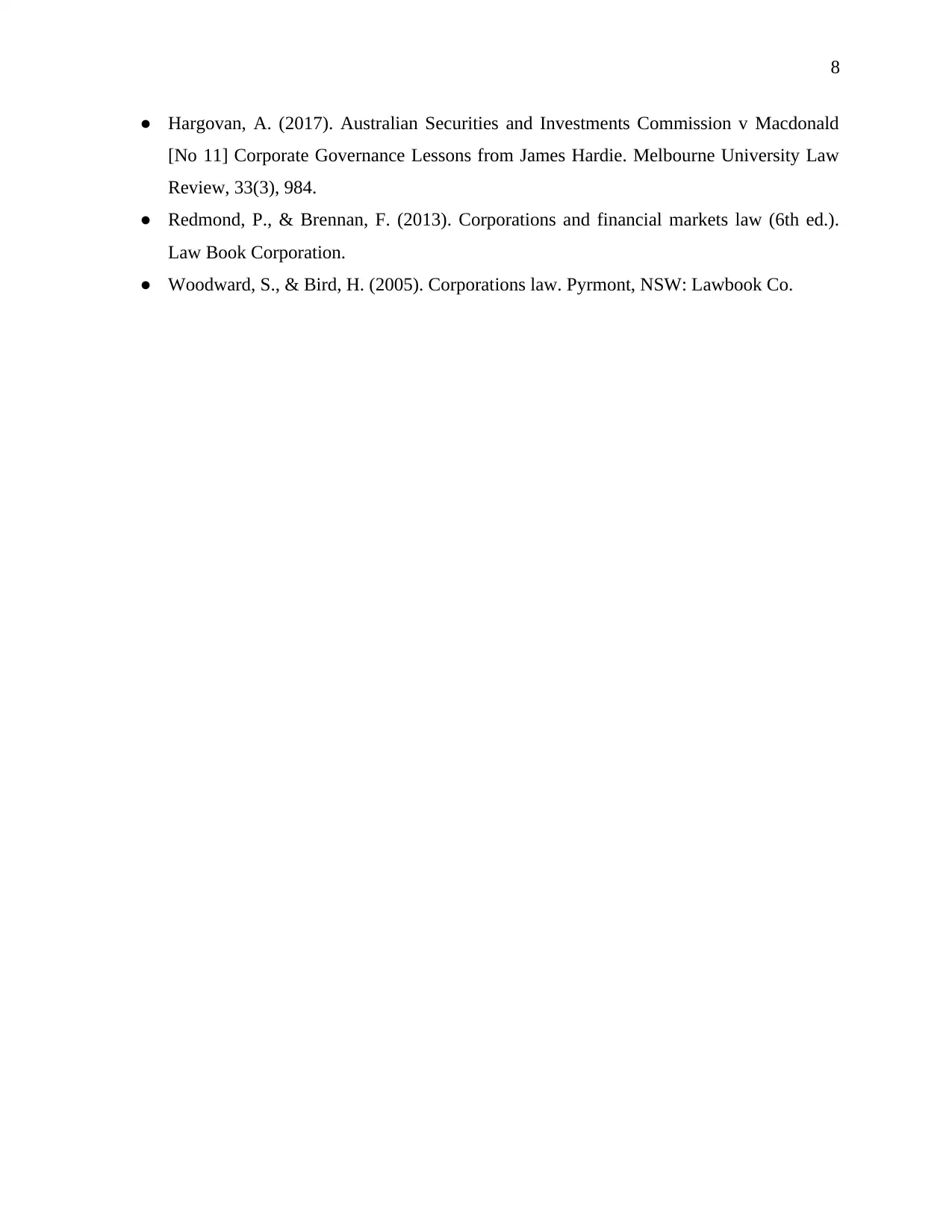
8
● Hargovan, A. (2017). Australian Securities and Investments Commission v Macdonald
[No 11] Corporate Governance Lessons from James Hardie. Melbourne University Law
Review, 33(3), 984.
● Redmond, P., & Brennan, F. (2013). Corporations and financial markets law (6th ed.).
Law Book Corporation.
● Woodward, S., & Bird, H. (2005). Corporations law. Pyrmont, NSW: Lawbook Co.
● Hargovan, A. (2017). Australian Securities and Investments Commission v Macdonald
[No 11] Corporate Governance Lessons from James Hardie. Melbourne University Law
Review, 33(3), 984.
● Redmond, P., & Brennan, F. (2013). Corporations and financial markets law (6th ed.).
Law Book Corporation.
● Woodward, S., & Bird, H. (2005). Corporations law. Pyrmont, NSW: Lawbook Co.
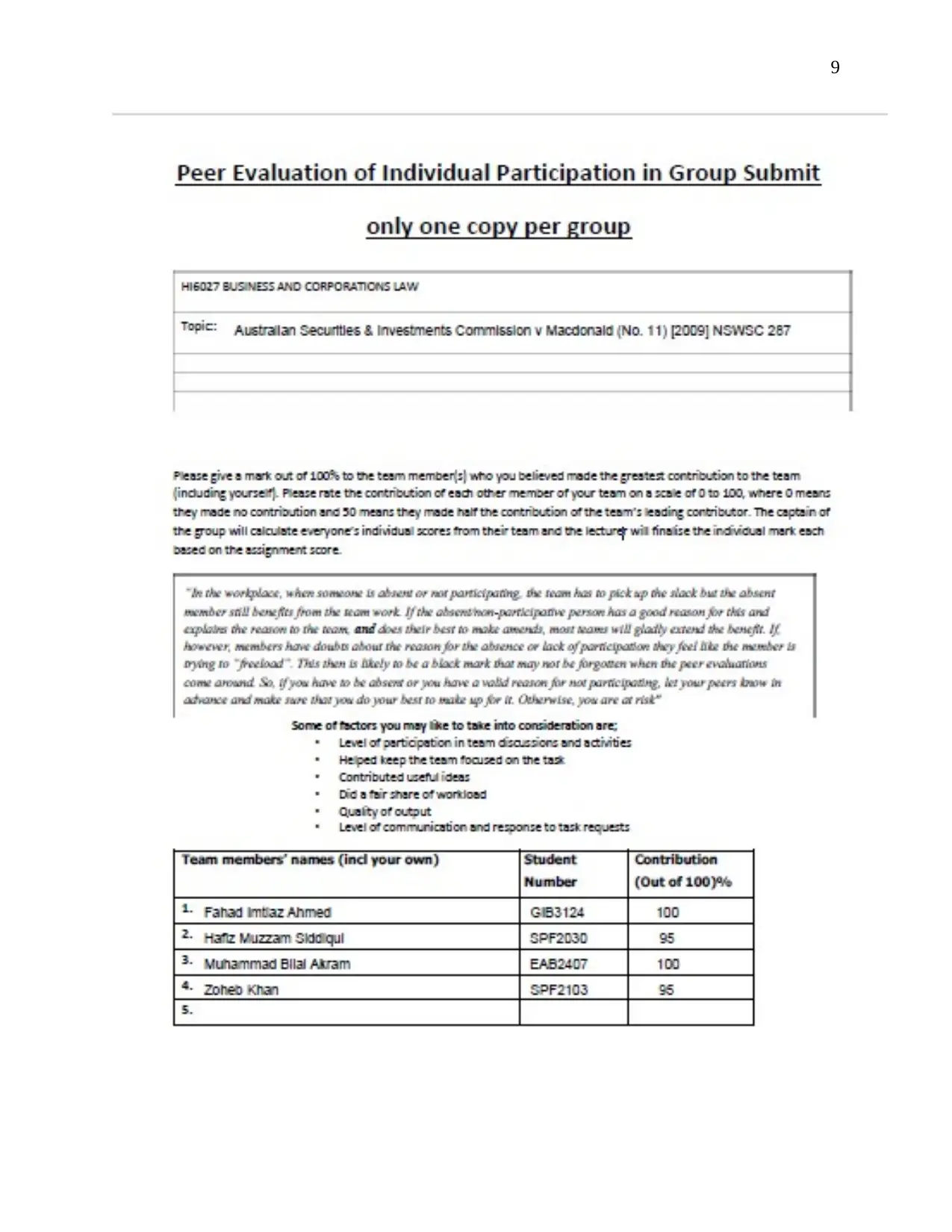
9
⊘ This is a preview!⊘
Do you want full access?
Subscribe today to unlock all pages.

Trusted by 1+ million students worldwide
1 out of 9
Related Documents
Your All-in-One AI-Powered Toolkit for Academic Success.
+13062052269
info@desklib.com
Available 24*7 on WhatsApp / Email
![[object Object]](/_next/static/media/star-bottom.7253800d.svg)
Unlock your academic potential
Copyright © 2020–2025 A2Z Services. All Rights Reserved. Developed and managed by ZUCOL.


![Case Study Analysis: Shafron v ASIC [2012] HCA 18 and Corporate Law](/_next/image/?url=https%3A%2F%2Fdesklib.com%2Fmedia%2Fimages%2Fen%2Fcbcdf6d2236f4eae97476bcab5958c46.jpg&w=256&q=75)


